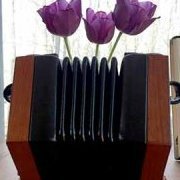-
Posts
48 -
Joined
-
Last visited
Podzol's Achievements

Advanced Member (3/6)
-

Fully chromatic concertina for Begginer
Podzol replied to choamnomsky's topic in General Concertina Discussion
I started playing EC because I was a tone deaf cellist. I liked the chromatic aspect of the instrument. I began on a Jack, because I could play the cello repertoire on it. I loved that box so much. I played the begeebers out of it. When I was convinced that this was a life-long source of joy and the bellows finally gave way (3 years, 3 hours/day), I did not hesitate to upgrade. I picked up a Morse Albion, then traded that for a Geordie when that came out. So, in summary, I strongly recommend the Jackie/Jack instruments to get you going! The little tunebook that comes with is a nice starting tutor, too. Then I went on to The Concertina Workshop by Alistair Anderson. -

My first composition! Dry Kindling for Doctor Mulligan
Podzol replied to Podzol's topic in Tunes /Songs
Thank you David for your observation. I entered the abc using the Craic app for ipad. I'll also have a listen to your suggested change. I appreciate that you took the time to play it and consider it so closely! Blake -

My first composition! Dry Kindling for Doctor Mulligan
Podzol replied to Podzol's topic in Tunes /Songs
Hi Mikefule! Nice to run into you again! Hope you're well. -

My first composition! Dry Kindling for Doctor Mulligan
Podzol replied to Podzol's topic in Tunes /Songs
Thank you, Wolf! These are great suggestions... I'll consider them as I make adjustments. I think you're absolutely right about it being more of a jig. I was pleased with those two bars in part B, as well. I wish I knew as much about music theory as you do! In time, if I keep at it, perhaps... -
After about a decade of enjoying such music on my English concertina, I finally decided to try my hand at composition. Thought I'd share. Hope you enjoy! DryKindling - 2_6_19, 8.49 AM.m4aDry Kindling for Doctor Mulligan.pdf X:1 T:Dry Kindling for Doctor Mulligan C:Blake Ketchum L:1/8 M:2/4 K:C (3GAB||:c>B c>g|(3agf e>g|(3edc G>c|(3ABc (3def| (3gfe a>f|(3gfe c>e|(3fed (3Bcd|1c2 (3GAB:||2c2g2| ||:(3efg (3c'bc'|(3d'bg (3d^cd|(3fef (3g^fg|(3def (3gab| (3c'ge (3ceg|(3agf (3efg|(3edc (3Bcd|1c2g2:||2c4||
-

drying out a concertina played in the rain
Podzol replied to Gail_Smith's topic in Instrument Construction & Repair
Agreed. The method of repair would depend upon what parts became moist, how moist, and whether they molded, warped, cracked, corroded, stiffened, delaminated, or otherwise failed. Hygroscopic moisture can persist a very long time in tight spaces beneath screw heads and tight seams causing problems down the road. Forcing it to dry might cause it to dry unevenly causing other problems. If you have a nice instrument that you'd like to preserve, I'd consider getting into a shop for a thorough go over. To add to the list of instruments for the rain, I'd like to add spoons, washboard, and voice. -
Podzol changed their profile photo
-

Why are there more anglo players than english?
Podzol replied to McDouglas's topic in General Concertina Discussion
I picked up EC because of the ability to play classical music in a variety of keys. I was initially an enthusiastic and tone-deaf cellist. Discouraged with my progress on that instrument, I switched to a baritone English concertina. I play a lot of folk music from the Isles and from Scandanavia, but also the classical music that I love to play. I'm quite happy with the instrument and am beginning to compose some arrangements with a countermelody in the lower register as well. I'm also working on playing a melodeon, and learning some of the joys and challenges of a diatonic instrument. I'm using the Milleret and Pignol tutors for that, so lots of crossing rows. With respect to those posts about the initial steepness of learning the English keyboard, I wholeheartedly agree. Just learning my first scale, I could also hear all kinds of humming and scratching sounds while my brain tried to format itself. But the effort paid off, and now playing isn't painful to my brain. :) -

Bellows Notation - Generally Accepted Standards?
Podzol replied to RobSay's topic in Teaching and Learning
I definitely like the idea of the < and > symbols, but > is already a musical symbol. I'm making some arrangements of classical music for EC, and so this is of particular interest to me. I'm using EasyABC, which has a great ABC editor and has pretty sharp rendering algorithms. ABC has limits, so I am just using the up and down bow symbols from strings. Up being pull and Down being push. I'm not complaining about ABC, I love that it makes laying music out so widely accessible with common tools. Playing the cello (in my mediocre fashion), the down-bow has a lot more power, which reminds me of the push on a concertina, so that's why I chose that particular symbol assignment. I agree that indicating bellows can make much clutter in a layout, but much like fingerings in some piano scores, if it is indicated only where it is either complicated or of strong preference to the arranger, it may not clutter so much. -

Bellows Notation - Generally Accepted Standards?
Podzol replied to RobSay's topic in Teaching and Learning
Here's a shot of how Regondi does it in an EC tutor: And Crabb in an Accordion tutor: (the V is push) And the American Accordion Association used arrows in 1938. In my notes I presently use bowing notation. What about three symbol notation, push, pull, and doesn't matter. Maybe: ⋃ for push - concave for reducing the bellows, ⋂ pull - convex for inflating the bellows, and ‖ for end of bellows instruction. Those seem easy to write, they are accepted digital characters (not to ABC, though), and seem somewhat intuitive to me at least. -
Thanks, Wolf! Yes, I do hear some mushy peas in there. Not quite soup, but almost. I'll work it at different tempos and think of nice hard dried peas. Wolf: By the way, Ive been enjoying your recordings, thanks for sharing them with the forum. Have you any transcriptions? I'd love to see how you put the accompaniment together. Everyone: your comments are much appreciated. I play in a relative vacuum (there is some air, of course), so it's fantastic to get some feed back from fellow players.
-
Thanks, Rod. A good suggestion. Will do!
-
Thanks, psmooze. I just joined a group of musicians who play Scottish music in a casual setting, so that will certainly help. I also think playing like peas in a pod will help stabilize my tempo somewhat too. I'll look into the transcribe program. My son has something that he uses for his music practice, called something else, but id does a similar thing. Thanks!
-
Thanks for the encouraging and detailed comment, Chas. I do appreciate it, and agree. I remember reading that peas in a pod passage in the Concertina Workshop book now that you mention it! I think also I would benefit from working with a metronome to help me regulate tempo. Sometimes my fingers run away from me if I have drilled a certain passage a great deal. Thanks again!
-
Here's my crack at this fun hornpipe by Scott Skinner after many months of whittling away at it. It's uneven here and there and not as crisp as I'd like it to be, but all the notes are there in approximately the right places. Have a listen and don't be too hard on me! I'm self taught. I play a Morse Baritone Geordie, which I am delighted with. I've linked to it here (.m4a) And here (.mov) and here (.wav)



